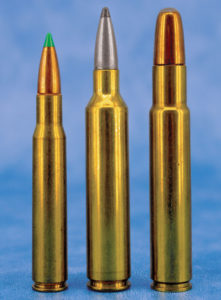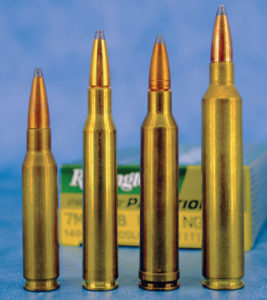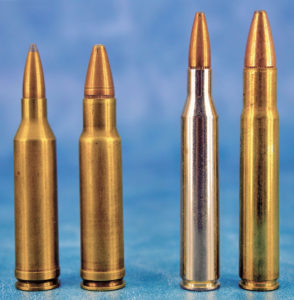
When it comes to defining magnum cartridges, it’s not as straightforward as you might think.

There was a time when the term “magnum” was fairly well defined. I’m talking back in the 1960s and 70s when the word pretty much meant a cartridge more powerful than “normal” and was usually based on the belted Holland & Holland case. In fact, in the eyes of many, if it didn’t have a belt, it couldn’t be a magnum—that’s how synonymous the two words became. As always, though, there were many exceptions to the rule. Back in its early days as a wildcat, for example, the .25-06 certainly provided magnum performance if the standard for the caliber was the .257 Roberts. Yet it was never called a magnum.
At the other end of the .25-caliber spectrum was the .256 Win. Mag., a bastard of a cartridge if ever there was one. Originally designed as a pistol cartridge, what limited popularity it achieved was in the Marlin Model 62 Levermatic rifle.
Based on the .357 Mag. pistol case necked down to .25 caliber, as a rifle cartridge it was pitiful, sending a 60-grain bullet of low sectional density and ballistic coefficient at 2,760 fps. If we again cite the .257 Roberts as representing the performance standard for the caliber, it would have qualified as a super magnum compared to the .256. Incidentally, I actually owned one of those Marlin Levermatics, and the .256 Win. Mag. was the cartridge with which I started my handloading career.
Anyway, another and even better example of confusing nomenclature is the .220 Swift. When it was introduced in 1932, it absolutely blew the doors off any other .22 centerfire cartridge, yet like the .25-06, it never received the magnum imprimatur. Even when the .222 Rem. Mag. was introduced in 1958, the Swift pushed the same weight bullets about 500 fps faster, yet it was…well, just a Swift, not a magnum.
Like I said, there are many exceptions to the rule, but for the most part there was some thread of consistency throughout cartridge nomenclature. I guess when you get right down to it, a cartridge is regarded as a “magnum” if its performance—usually based on velocity, but not always, as in the case of shotshells—is higher than the nominal standard. Today we have many true magnums that have no belt, plus we have short magnums, ultra magnums and “enhanced performance” cartridges, so determining what those standards are is a lot more confusing than it used to be.

I do think, however, we would all agree that the performance “standard” for our two most popular hunting calibers, the 7mm and .30, are represented by the .280 Rem. and the .30-06. In other words, a muzzle velocity of around 2,800-2,850 fps for a 150-grain 7mm bullet, and 2,750 or thereabouts for a 180-grain bullet in a .30-06, represent “standard” cartridge performance for those respective calibers.
Any cartridge that increases those nominal velocities by 150-200 fps would qualify as a magnum, whether they’re called that or not. Continuing that thread, the 7mm Rem. and .300 Win. best exemplify what most of us mean by “magnum” in those respective calibers. Of course we now have the 7mm and .300 WSM, which duplicate the aforementioned rounds, but with a shorter, squatter case, and without that once almost-mandatory appendage known as a belt.
Then we have in those same two calibers the 7mm and .300 Remington Ultra Magnum, both of which deserve that superlative moniker because they do indeed provide another significant step up in performance over “standard magnums,” if you will, which has to qualify as an oxymoron if ever there was one.
Boosting Velocities
What in recent years has further blurred the lines between standard, magnum and ultra magnum performance is best characterized by Hornady’s original Light Magnum line of enhanced performance ammunition.
By using proprietary loading procedures and propellants specifically formulated for them, Hornady was able to boost velocities in non-magnum cartridges by as much as 140 fps over the nominal standards, with no increase in pressures. After a couple of years, Hornady applied that same technology to magnum calibers, but it felt it had to somehow distinguish it from non-magnum calibers, so it was called Heavy Magnum, even though the velocity gains averaged about the same.

For example, the Light Magnum 165-grain .308 Win. load clocked 2,840 fps compared to 2,700 for the standard loading. In .300 Win. Mag. the Heavy Magnum load exited at 3,120 fps, or 170 fps over the standard load. Thankfully, the folks at Hornady realized the potential for confusion and have since chosen to change the name to Superformance, and it applies to all such enhanced loadings, whether magnums or not.
Further blurring the lines between standard and magnum performance is that Hornady has applied this same technology in its development of proprietary cartridge lines for Ruger, Thompson/Center and Marlin. The Ruger Compact Magnums, the .300 and .338 T/C, and the .300 and .338 Marlin Express, are all examples of cartridges that provide significantly more velocity than they could otherwise given their case capacities.
Even more dramatic, though, is the performance gains achieved when these same loading techniques are applied to classic lever-action cartridges like the .30-30, .35 Rem., .444 Marlin and .450 Marlin in conjunction with Hornady’s development of FlexTip bullets. The overall performance of these old guns have been elevated to where they would qualify as “magnums” when compared to the standard loadings and the flat- or round-nosed bullets these guns were traditionally saddled with.
No sir, the term “magnum” doesn’t have quite the same connotations it once did. There are cartridges today that produce magnum and even super-magnum performance, yet are not so designated—the 7.82 Lazzeroni Warbird and .460 Dakota are consummate examples. Then there are those that wear a belt and don’t qualify, such as the 6.5 and .350 Rem. Mag.; they only duplicate, if that, the performance of the 6.5-06 wildcat and the .35 Whelen, respectively.
This article appeared in the Summer 2015 Ammo Issue of Gun Digest the Magazine.

Next Step: Get your FREE Printable Target Pack
Enhance your shooting precision with our 62 MOA Targets, perfect for rifles and handguns. Crafted in collaboration with Storm Tactical for accuracy and versatility.
Subscribe to the Gun Digest email newsletter and get your downloadable target pack sent straight to your inbox. Stay updated with the latest firearms info in the industry.

![Best Concealed Carry Guns In 2025 [Field Tested] Wilson Combat EDC X9S 1](https://gundigest.com/wp-content/uploads/Wilson-Combat-EDC-X9S-1-324x160.jpg)


![Best 9mm Carbine: Affordable PCCs [Tested] Ruger Carbine Shooting](https://gundigest.com/wp-content/uploads/Ruger-Carbine-Shooting-100x70.jpg)
![Best AR-15: Top Options Available Today [Field Tested] Harrington and Richardson PSA XM177E2 feature](https://gundigest.com/wp-content/uploads/Harrington-and-Richardson-PSA-XM177E2-feature-100x70.jpg)

Have always been very old school about magnum rifle cases. The belt is the formal attire for such ammo. Otherwise it’s just a big hogging cartridge.